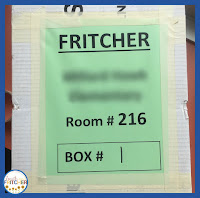It’s that time of year to start thinking about what worked this year and what we can do to improve next year. I’ve had a lot of “end of year” school years. Throughout that time, I’ve learned a few tricks to help make the start of next year a little bit smoother.
1. Copies for the Fall
I start going through all the activities and original copies that I used for the year. Then I make a list of all things that I want to use again. This list works as a rough draft for plans but also a check off list for my printing assignments. Our district uses digital printing so I can upload the PDFs for the copies I want printed. I know I will add and supplement with new activities, but I like to send all of my copies for September and October before the school year ends. I set the copies due date for the first week of June so I can check it off my list and store it for the summer. It will be one less thing I need to do as I prep my room for the new students coming in!
2. Packing
Each year we have to take everything off our walls and pack up as much as we can so they can move out all of our furniture to wax our floors. This year we have to move our classroom to another building so we have to do “real” packing. But I use the same process either way!
As a team we make a label sheet on standard copy paper that has my name, room number, and a place for a box number. We send this to printing and request about 100 copies for each of us. Each teacher has a designated paper color for his/her sign. It’s a quick way to differentiate which box belongs to which teacher. With a complete move (including the furniture), everything gets a label sheet and number: chairs, tables, bookcases...everything.
As I start packing, I tape the label sheet on the box and number it. I also create a spreadsheet that will tell me which box has which items inside. When I unpack later, the spreadsheet will help me know which boxes contain what. I use the spreadsheet to determine which boxes to unpack and where. I also use the chart to organize the order I unpack boxes. For instance, I’ll put all construction paper-containing boxes near the cupboard where I will store construction paper. I might just move them there during the initial sorting phase and empty them out at a later time. As I empty boxes, I check them off my spreadsheet. The spreadsheet also helps me realize if a box or group of boxes doesn’t make it to its new destination.
 |
| Label Your Boxes: Name, School, Room #, and Box Number |
3. Bulletin Boards
Most years we can keep our bulletin boards up as long as we cover them. We hope that the summer staff doesn’t get anything wet and most times we are good. But if you have to take them down each year here is a quick idea to keep all of your bulletin board materials together.
I usually spent a lot of time layering and mix and matching different borders. To save time later on, I keep the materials together to replicate it for the next year. I dismantle a bulletin board one at a time. I take all the staples out so they are ready to go in the fall. I roll up the borders in a rosette shape. As soon as all of that bulletin board stuff is rolled up, I use a large binder clip to hold it all together. Then, I also label which bulletin board it belongs to. This way in the fall you just have to put up new paper and your borders are matched and measured for easy assembly.
In the past we have used plastic dollar store table cloths or fabric for the backing of the bulletin board. But some years the district has given us issues over them being a fire hazard. So I found a better solution! I found rolls of white wrapping paper at the dollar store. This works great and matches any color combination that you use to decorate.
4. Planning Spreadsheet
My fourth grade team has created a google sheet to lay out our content literacy and standards plan of attack. This is powerful when you see what articles and books you are using for each lesson. It demonstrates where you have gaps and where you need to incorporate different lessons for different standards. This also leads my team to the discussion about spiraling curriculum. We want the students to work towards deeper learning over mastery. The more exposures and applications students have to standards and skills, the deeper the learning will be. It is even more powerful when we are hitting those areas in Social Studies and Science!
The NYS standards (NYS Next Generation Standards) have been revised to combine the old literature and informational standards. So, instead of keeping track of 2 sets of reading standards, it has been condensed into one!
These are some simple things that will help you think about how you will wrap up your school year while still preparing for the start of the next. As we get more experienced as teachers, we learn a few tricks that make us say, “Why didn’t I think of this sooner?”